Rural Rajasthan - Arts of Rural Rajasthan
|
|
|
|
Arts of Rural Rajasthan
|
|
The tourists especially came to Rajasthan
to experience its rich customs, culture and traditions. Some of the famous
traditional arts of Rural Rajasthan are body painting or tattoo,
Mehandi and Puppetry. The tourists are not only attracted towards them but
are also attracted towards turban, textiles and tie and dye of Rural
Rajasthan. |
| |
|
The Art of Body Painting
in Rural Rajasthan |
|
A tattoo is a painful art of
inserting various colourful pigment into the skin. In technical
terms, it is known as the micro pigment implantation. Rajasthani
tattoos are very much popular around the world and you can find most
of the tourists expressing their interest in getting them done. The
tattoos represents the tribal aspect of various groups with the
unique patterns, which are very enchanting and powerful in nature.
The Rajasthani women are very much fond of tattooing themselves as
they believe that drawing tattoos will enhance their beauty and
health. The tribal women of Rajasthan also strongly believe that
tattoos are the only marks, which are carried by the soul after
death. This tribal tattoo art, which has great significance and
belief, since the times of kings and queens has now become more
popular among the tourists. It is an ancient practice, which was
|
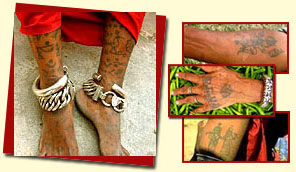 |
|
|
usually performed to represent the tribal
communities of Rajasthan. Some of the favourite designs are dot
pattern, circles and crescents on the face, parrots, scorpions, flowers
and images of gods and goddesses on the arms. A wide variety of
floral patterns, trees of eternal life (Kalpa Vraksha) and animals like
Horse, camel, crocodile and a pair of peacocks are also applied over the
calves and between the breasts of women. Some women also get the names of
their husbands tattooed on the forearms as a token of their devotion and
love. A dot on the forehead signifies Lakshmi, the goddess of wealth and
prosperity, round clusters of dots with ray like appendages signifies
Lotus (Kamal) or sacred wheel (Chakra) and Swastika signifies the sun.
Traditionally the horse is associated with sun, the crocodile with goddess
Ganga and the camel with regional God Gogaji, who is believed to have
domesticated it for the first time. An interesting aspect of tattooing
among the women is that the designs were used as a family heritage. Thus,
the tattoo designs on the bodies of the elders are adopted by the younger
ones in the family and this goes on from one generation to the other. |
| |
|
Process of Tattooing |
|
|
Once the tourist decide the design to be done over the chosen part of
the skin, then the local Rajasthani tattooist punctured the desired
pattern into the skin by means of sewing needle, which at times can be
very much painful. When this pattern becomes visible and blood oozes
out from various prick points, the design is rubbed by the lamp black
and pressed by a thumb. The sap of a common herb (dudhi) is then
|
 |
|
|
applied as
an antiseptic, to get the permanent designs. |
| |
|
Mehandi in
Rural Rajasthan |
|
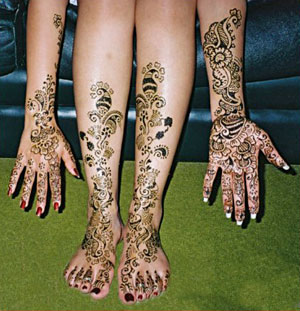 |
In Rural Rajasthan, Mehandi is a very ancient
folk art, which signifies life and prosperity. Mehandi is also known
as henna, which is a temporary art of skin decoration. It is one of
the most precious jewel for brides, and carry good luck for their
married life.
Mehandi is applied on various
auspicious occasion like wedding, festivals, birth of a child. Today,
the tourists have now become more interested in Mehandi, specially in
its various mehandi patterns and designs and its lasting impact. Henna
is considered to be an ancient herb of grace and healing. Once you
apply on skin, it act as a valuable medicine, thus protecting the body
from fungi and bacteria. It helps in headache, fever, burning feet,
violent temper, keeping the body temperature cool and conditioning and
gives natural colour to the hair. From late 1990s, the Rajasthan's
Mehandi art has ruled the fashion market of the world and became
famous and was popularly known as "Henna Tattoos". There are different
forms of designs and patterns used at the time of various festive
occasions. Although there are large variety of patterns, but the
pattern known as chowk, literally meaning a courtyard, is most popular
with the women. There is a specific design of Chowk for Gangaur, Teej,
Holi and other festivals. The other favorite design is chopper, which
is a game, played by |
|
|
throwing dice. Pankhi or Beejani, yet another
fabulous pattern, meaning a hand-fan, is a typical design for the
summers. The famous lahriya pattern, which literally means a wave or a
ripple, is the most popular pattern in the rainy seasons. In
Rajasthan, Mehandi has achieved great significance and linked to
spacious occasions like Karva Chauth, Raksha Bandhan, Weddings, Teej
and all other related occasions. Bridal Design, Arabic Design, Henna
Tattoos, Saroski Design, Crystal Patterns are the famous designs and
patterns of Mehandi. |
| |
|
Process to Apply Mehandi |
|
In the olden days, Mehandi paste was
usually applied on the skin by using match sticks, but now the match
sticks have been replaced by the plastic cone or a paint brush. Once all
the items are ready, then various delightful patterns are applied with the
help of plastic cone on hand or feet. After applying, the hands or feet
are wrapped with the tissue, plastic, or medical tape to lock in the body
heat, so that it can create more intense colour on the skin. Then, leave the paste on your skin for at least 8
hours.
Then remove dry mehandi by rubbing, after rubbing apply mehandi oil
on the skin. It is advisable not to wash hands with the water and
not to use any soap or cream on the design of the mehndi for about
24 hours. |
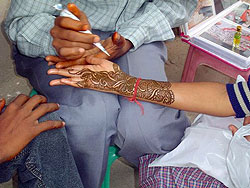 |
|
|
|
|
|
Puppetry in
Rural Rajasthan |
|
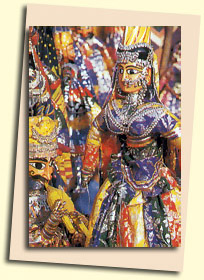 |
The Puppets are locally known as
Katputlis in the colourful soil of Rural Rajasthan. The puppetry is one of
the most ancient forms of entertainment and amusement. Besides
providing enjoyment, they also convey a meaningful message to the
village folks. Rod puppetry, Glove puppetry, String puppetry, Shadow
puppetry, String-Rod puppetry are the different types of traditional
puppetry. No fair in the village, or religious festival, or the social
gathering is complete without the charm of puppetry. Puppetry is a
creative, exiting and entertaining form of art, and requires special
skills to play these magnificent puppets through fingers. The episodes
from Indian epics like Mahabharata, Ramayana and exploits of Amar
Singh Rathore of Nagaur are depicted by the puppeteers. This art is
very popular among the rural folks. The puppetry has a very long and
interesting history. According to myth, the puppeteers were from the
wandering communities of Bhats in rural Rajasthan, traditionally
associated with the art of puppetry and were originally inhabiting the
area around Nagaur in the Marwar region. They used to move from one
village to another, at the time of festive seasons, with their box of
katputlis and dholaks, spreading the unique art and culture. The
another most influential story states that once there was a carpenter,
who made two alluring wooden figures and when goddess Parvati saw
them, she slipped into the figures in a playful mood, and later the
Lord Shiva also entered in the other figure and both of them started
playing a divine dance. |
|
|
By watching this, the carpenter thought that
his creation has came alive, but after a while they become lifeless.
Since then, Lord Shiva and Goddess Parvati have blessed the
innovation. This was how the puppetry was born. Good fabric for
costume, colours to give facial expressions, plaster of paris or clay
modelling to make body, wood material for face and other items,
invisible threads to play and colourful papers are used in the puppet
show. Puppetry is one of the most costly medium of entertainment, as
it involve activities like drawing, painting, wood carving, carpentry,
plaster cast making, clay modeling, costume designing, story, script
writing, dramatization, song and music composition. The puppets are
beautifully decorated, and manipulated with the help of strings, thus
the strings are looped into the hands and fingers of puppeteer. The
show starts with the fanfare of loud beats on the dholak, a drum which
is played by the female members of the troupe, whereas the whistling
and puppet playing is done by the puppeteers or male members, who
produce sharp, trembling and shrilling sounds through the rustic reeds
they hold in their mouth. The dialogues in the play are narrated by
the female members through appropriate songs. However, a cloth is
placed over the cots to hide the performer from the public gaze. He
moves the joined limbs of the puppets with the help of strings
attached to each of them, the loose ends being looped over the puppets
which effectively convey the broad sentiments of each character they
represent in front of public. These stunning puppets lie lifeless on
the stage until the strings are pulled by the puppeteer. Most of the
puppeteers are usually from the same family, and this occupation
passes from one generation to another. In Rural Rajasthan, puppet
shows are organised to ward off evil spirits and to bring rain and
prosperity in the lives of villagers. Most of the puppet shows are
played only for a hour or so, which is much liked by the young
children. However, today, most of the Rajasthan puppet theaters have
lost their charm, due to the influence of cinema, television and
video. But still puppetry is a popular among the children, educators
and communicators. Today, the Rajasthan Government, has realized the
importance of saving this ancient art of folklore and taken
initiatives to open many puppetry theaters and also regularly organise
puppet shows in the countryside of Rural Rajasthan. Nowadays, various stage
shows are organised for puppetry, followed by the full-throated songs
of the Mirasis, Langas and Manganiyars, which belong to old pastimes,
depicting a traditional, leisurely pace of life. |
| |
|
Turban in Rural
Rajasthan |
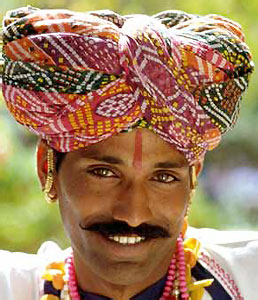 |
The turbans of Rural Rajasthan are the most colourful and impressive in
the whole of India. The use of turbans was
basically started by the Rajput community, who reside in Rajasthan and
wear distinct turbans. In the Hindi language, turban is known as Paag,
Safa or Pagri. It is also said that the style of the turban changes
with every 15 km you travel within the geographical boundaries of
Rajasthan. In some parts of the region, the size of turban indicate
the position of the person in the society they live. The tourists have
also become attracted towards these turbans and also enthusiastically
participate in turban tying competitions held in many fairs and
festivals of Rajasthan. The Maharajas of Rajasthan were also known for
their colourful traditional costumes and grand turbans. The turbans
are worn as a long scarf wrapped around the head of men, as a sign of
identification and social prestige. Each colour of the turban has its
own importance and significance. Ochre is the colour of the mendicant,
while the saffron is commonly worn at the time of weddings. In the
medieval past, the saffron colour also denoted valour and chivalry. A
turban is usually 82 feet long and 8 inches wide and achieving
different styles with this unstitched cloth, requires great skill.
Skilled maidens in turban tying, were employed by the royal courts,
but Rajasthanis generally take pride in practicing and perfecting the
art of turban-tying themselves. When the rulers were besieged by an
enemy, and food and water supplies were scanty, desperate warriors
wearing saffron turbans would sneak out of their citadels to lead
sudden surprise |
|
|
attacks on the enemy. The Pancharanga or five colour
turban is the main turban in the colourful soil of Rajasthan. Turbans
of specified colours were worn to mark periods of mourning. A white
turban is worn for funeral processions by immediate family members.
Whereas the khaki, blue and dark maroon are reserved for the
solemnity of a condolence visit. In Rajasthan, shepherds wear red
turbans, Bishnois wear white turbans and the other tribal communities wear
printed turbans. Between the month of February and March and Holi
festival, the royal Rajasthani men, wear a falgunia turban having
white and red designs. In the month of July, they wear turban of
motiya or pearl pink colour. A green and pink striped or yellow and
red striped lahariya turban is worn during the time of monsoon. The
famous Black Chunari (tie dyed) with the red borders is mainly worn at
the time of |
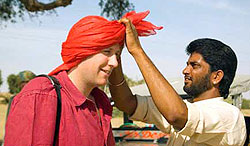 |
|
|
Diwali, festival of lights and a bright Saffron colour
turban is worn in the Dussehra festival. The Mothara turban, with tiny
round designs is worn at the time of Raksha Bandhan festival, yellow
turban is worn during Basant Panchami (spring festival) and the light
pink turban is worn in the month of October, at the time of Sharad
Poornima (full moon night). The turban's size and shape is also
influenced by the climatic conditions of the different regions.
Turbans in the hot desert areas are large and loose. Farmers and
shepherds, who need constant protection from the elements of nature
wear long turbans. Rough fabric turbans can be used as blanket. The
long turbans can also be used as the pillow, blanket and towel. The
muddy water can also be strained through a turban. It can also be used
as a rope to draw water from a well with a bucket. |
| |
|
Textiles in
Rural Rajasthan |
|
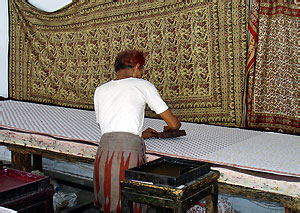 |
Rajasthan is the heartland
of hand-block printing. Magical uniqueness of Rajasthani
block printing still continues to spread colour with its
exquisite floral prints in vegetable colour. Stunning,
unusual combinations of pink, purple, orange, turquoise,
parrot green, saffron, crimson and gold and silver colour
add the beauty to the fabric. In the hand block printing,
the artisans soak carved wooden blocks in different
colours and then paste them on the fabric thus creating
some magical wonder on the piece of cloth. Exquisite
floral prints and designs made in vegetable colour is the
specialty of Rajasthan block printing. The art of Khari or
overprinting in gold is also practiced in Rajasthan. This
makes the traditional form of block printing even |
|
more charming and
contemporary. Now a days, printed fabrics are produced by
machines that have threatened the age-old art of block
printing. If the print is made by hand, there will be
block marks on the reverse side of the print at the
regular interval, with slightly messy corners running
towards the center of the piece. Sometimes machine prints
also copy these untidy lines, but the similarity of color
pattern, and clean print on the reverse side, make it
quite simple to mark them as impersonators. Rajasthani
textiles came in a fascinating range of dyed and
block-printed fabric which are further embellished with
embroidery. The women of Rajasthan have mastered the art
of embroidering fabrics. In applique, different pieces of
cloth are patched together to make a multi-coloured
mosaic. The exotic colours, shapes and pattern
combinations against contrasting backgrounds catch the
eye. Inspired from Gujarat, the mirror work is also famous
among the local women and people. The extraordinary
creation of art with the help of a piece of cloth and
needle-thread can never be as amazing as Rajasthani
embroidery which is visible from the exquisite applique
and mirror works of the state. |
| |
|
Tie and Dye in
Rural Rajasthan |
|
Rajasthan is also known for some
excellent fabric and the most precious one is the tie and dye work
which is also called 'bandhni' in local language. The art of bandhani
is highly skilled process and Rajasthani artisans have come a long way
in developing new designs and patterns. Now the tie and dye clothes
are one of the most exported fabrics of India. The tourists have
always became attracted towards the heart-warming designs, dyed in a
particular style. Colour also plays a unique role in tie and dye
fabrics. In tie and dye, different methods are used to tie the fabric
into small points producing a number of patterns. Lahariya, Mothda,
Ekdali and Shikari are the most popular patterns among all the styles
of bandhni and exhibit a unique look and nature. In Lahariya, the long
lines of various colour runs diagonally through the entire piece of
cloth. In Mothra, a checked effect is shown with opposite diagonals
and coloured lines. Shikari designs include human and animal figures
along with multi coloured Laddu and Jalebi patterns. The human and
animal |
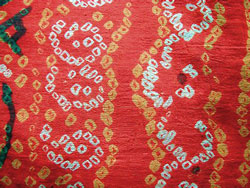 |
|
|
figures depicted nicely in the dazzling colours is the identity
of Shikari bandhni. In Ekdali pattern, there are small circles and
squares in different shades of colour and the cluster of three, four
and seven multi coloured dots make it even more gorgeous. Sikar and
Jodhpur are the most favoured destinations for excellent tie and dye
work while Jaipur, Barmer, Pali, Udaipur and Nathdwada are still on
their way to attain the maximum height. |
|
|
|
|
|
|
|
|
|
|
|
|
| |













